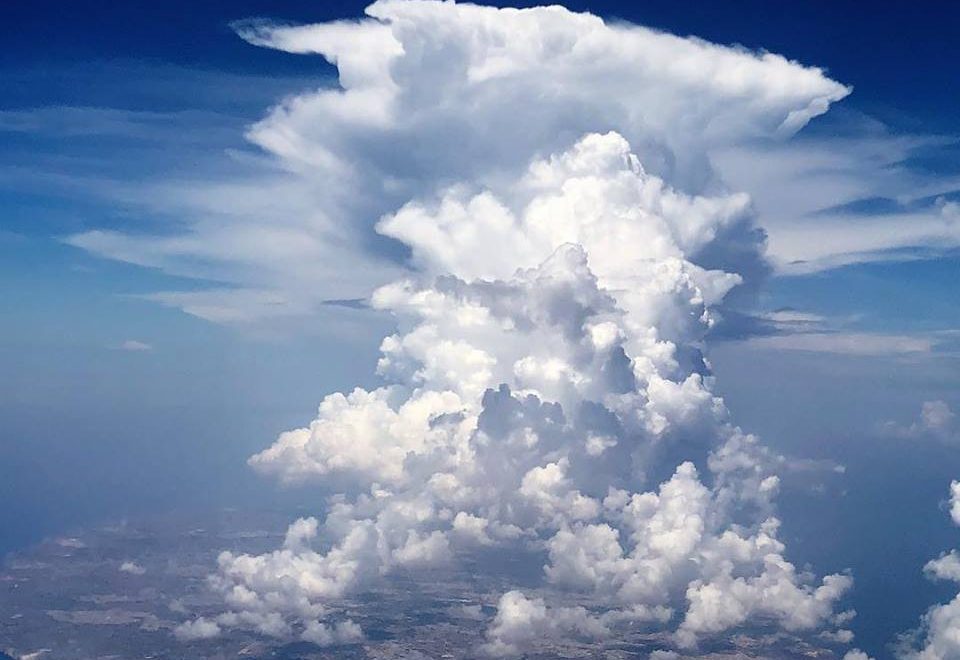
The central Mediterranean will continue to find itself under the influence of a weak area of high pressure for now. This weak area of high pressure will be enough to maintain stable weather conditions across our region. Just as we have maintained for weeks, no further heat spells or heat waves are expected locally this summer. This is because the high pressure covering the central Mediterranean is not strong enough to support the northward extension of hot plumes from north Africa. Simultaneously, this high pressure is strong enough to prevent low pressure systems from penetrating the central Mediterranean. As a result, the Maltese Islands will enjoy stable weather conditions. This will be the case for the coming week. Temperatures will be at around average for this time of year, with highs of 29 C to 32 C and lows of 22 C to 24 C. The wind will be mainly light. An interesting phenomenon taking place around us at this time of year is the ‘għarixa ta’ Santa Marija’. This term refers to the partly cloudy sky which starts to characterise our weather by mid-August. These cumulus clouds normally start forming in the week after Santa Marija, hence their name. The appearance of these cumulus clouds indicates the presence of weak high pressure across our region. They are formed by the upward convection of columns of warm, moist air on sunlit days. This leads to the condensation of water vapour and thus the formation of these clouds. It is a process triggered by a clash between cooler air from the north and the warm sea/land locally. If the process starts in the morning, the clouds could reach substantial sizes by later in the day. In this case, a little rain may occur. The clouds dissipate by the evening, as they stop receiving energy from the sun. No rain is anticipated this week.
Iċ-ċentru tal-Mediterran se jkompli jsib ruħu taħt l-influwenza ta’ roqgħa dgħajfa ta’ pressjoni għolja għal issa. Din ir-roqgħa dgħajfa ta’ pressjoni għolja se tkun biżejjed biex tassigura temp stabbli fir-reġjun tagħna. Eżatt kif ilna ngħidu għal ġimgħat sħaħ, mhux qed nistennew aktar mewġiet ta’ sħana dan is-sajf. Dan minħabba l-fatt li l-pressjoni għolja li għandna fuqna bħalissa mhux b’saħħitha biżejjed biex iġġib arja sħuna ħafna minn l-Afrika ta’ fuq lejn iċ-ċentru tal-Mediterran. Fl-istess ħin, din l-istess pressjoni għolja hija b’saħħitha biżejjed biex iżomm il-bogħod sistemi ta’ pressjoni baxxa. Għal din ir-raġuni, il-Gżejjer Maltin se jgawdu minn temp stabbli matul il-ġimgħa li ġejja. It-temperaturi se jkunu madwar il-medja għal dan iż-żmien tas-sena, bl-ogħla ta’ 29 C sa 32 C u l-anqas ta’ 22 C sa 24 C. Ir-riħ se jkun il-biċċa l-kbira ħafif. Fenomenu interessanti li qed iseħħ madwarna bħalissa hu l-‘għarixa ta’ Santa Marija’. Dan jirreferi għal sema ftit imsaħħab li ġeneralment jibda jikkaratteriżża t-temp tagħna minn nofs Awwissu. Dan is-sħab tat-temp Cumulus normalment jibda jifforma fil-ġimgħa ta’ wara Santa Marija. Hu ħa dan l-isem minn hekk. Il-formazzjoni ta’ dan is-sħab tindika l-preżenza ta’ pressjoni għolja dgħajfa fir-reġjun taċ-ċentru tal-Mediterran. Dan is-sħan jifforma bil-konvezzjoni ta’ kolonni ta’ arja sħuna u umda f’jiem ta’ xemx. Dan il-proċess biex l-umdita f’dawn il-kolonni ta’ arja tikkondensa u tifforma sħab. Dan il-proċess iseħħ meta jkun hemm kuntatt bejn arja frisk mit-tramuntana u l-art/baħar sħun lokalment. Jekk il-proċess jibda kmieni filgħodu, jistgħu jikbru sew sa tmiem il-jum. F’dan il-kas ikunu kapaċi jagħtu xi ftit xita. Dan is-sħab normalment jisfaxxa fix-xejn sa filgħaxija, hekk kif jieqaf jirċievi sħana mix-xemx. Mhux qed nistennew xita din il-ġimgħa.


0 comments
Write a comment